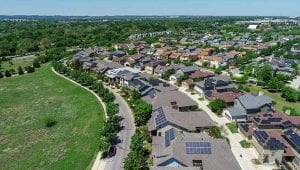Western Australia’s South West Interconnected System, regarded as the biggest isolated grid in the world, hit a new penetration record for wind and solar power over the weekend, a new peak of 85.1 per cent.
The milestone was noted on LinkedIn by the state’s co-ordinator of energy, Jai Thomas, referring to data displayed on the Australian Energy Market Operator’s data dashboard. It said 85.7 per cent at the time but was later adjusted by AEMO to 85.1 per cent, with the difference being sheeted down to actual versus estimated rooftop PV output.
The new peak was reached at 1.40pm local time on Sunday and beat a previous record of 84 per cent. It comes just days after the same grid reached a new peak of 80.5 per cent penetration just from rooftop solar.
On Sunday, rooftop PV accounted for most of the output with a 73.5 per cent share of demand, with wind providing 10 per cent and grid scale solar – most likely curtailed because of the competition from rooftop PV – accounting for less than one per cent.

While other grids have regularly reached higher wind and solar penetration – rooftop solar in South Australia accounted for more than 100 per cent of state demand, not for the first time, over the weekend – the remarkable feature about the W.A. is that it has no connections to other states, so cannot export excess output to other grids.
“It’s fantastic to keep pushing the envelope,” Thomas wrote on LinkedIn.
The W.A. grid has a relatively flexible system, because of its traditional reliance on gas, although it is rapidly building a fleet of large batteries – including the biggest in the country at Collie – that will provide added flexibility and soak up rooftop solar in the middle of the day to inject back into the grid in the evening peaks.
Those big batteries will also be crucial when the last of the remaining coal fired generators – all sited in and around Collie – close as expected by the end of the decade.
Note: This story has been updated to include the new AEMO figures.










